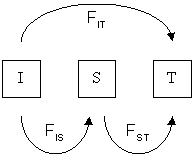F-statistics
In
F-statistics can also be thought of as a measure of the correlation between genes drawn at different levels of a (hierarchically) subdivided population. This correlation is influenced by several evolutionary processes, such as genetic drift, founder effect, bottleneck, genetic hitchhiking, meiotic drive, mutation, gene flow, inbreeding, natural selection, or the Wahlund effect, but it was originally designed to measure the amount of allelic fixation owing to genetic drift.
The concept of F-statistics was developed during the 1920s by the American geneticist
F can be used to define effective population size.[further explanation needed]
Definitions and equations
The measures FIS, FST, and FIT are related to the amounts of heterozygosity at various levels of population structure. Together, they are called F-statistics, and are derived from F, the inbreeding coefficient. In a simple two-allele system with inbreeding, the genotypic frequencies are:
The value for is found by solving the equation for using heterozygotes in the above inbred population. This becomes one minus the observed frequency of heterozygotes in a population divided by the expected frequency of heterozygotes at Hardy–Weinberg equilibrium:
where the expected frequency at Hardy–Weinberg equilibrium is given by
where and are the
For example, consider the data from
| Genotype | White-spotted () | Intermediate () | Little spotting () | Total |
|---|---|---|---|---|
| Number | 1469 | 138 | 5 | 1612 |
From this, the
The different F-statistics look at different levels of population structure. FIT is the inbreeding coefficient of an individual (I) relative to the total (T) population, as above; FIS is the inbreeding coefficient of an individual (I) relative to the subpopulation (S), using the above for subpopulations and averaging them; and FST is the effect of subpopulations (S) compared to the total population (T), and is calculated by solving the equation:
as shown in the next section.
Partition due to population structure

Consider a population that has a
This may be further partitioned for population substructure, and it expands according to the rules of
Fixation index
A reformulation of the definition of would be the ratio of the average number of differences between pairs of chromosomes sampled within diploid individuals with the average number obtained when sampling chromosomes randomly from the population (excluding the grouping per individual). One can modify this definition and consider a grouping per sub-population instead of per individual. Population geneticists have used that idea to measure the degree of structure in a population.
Unfortunately, there is a large number of definitions for , causing some confusion in the scientific literature. A common definition is the following:
where the variance of is computed across sub-populations and is the expected frequency of heterozygotes.
Fixation index in human populations
It is well established that the genetic diversity among human populations is low,[3] although the distribution of the genetic diversity was only roughly estimated. Early studies argued that 85–90% of the genetic variation is found within individuals residing in the same populations within continents (intra-continental populations) and only an additional 10–15% is found between populations of different continents (continental populations).[4][5][6][7][8] Later studies based on hundreds of thousands single-nucleotide polymorphism (SNPs) suggested that the genetic diversity between continental populations is even smaller and accounts for 3 to 7%[9][10][11][12][13][14] A later study based on three million SNPs found that 12% of the genetic variation is found between continental populations and only 1% within them.[15] Most of these studies have used the FST statistics [16] or closely related statistics.[17][18]
See also
- Malecot's method of coancestry
- Heterozygosity
- QST-FST analyses
References
External links
- Shane's Simple Guide to F-Statistics
- Analyzing the genetic structure of populations
- Wahlund effect, Wright's F-statistics Archived 2005-05-27 at the Wayback Machine
- Worked example of calculating F-statistics from genotypic data
- IAM based F-statistics
- F-statistics for Population Genetics Eco-Tool
- Population Structure (slides)
























